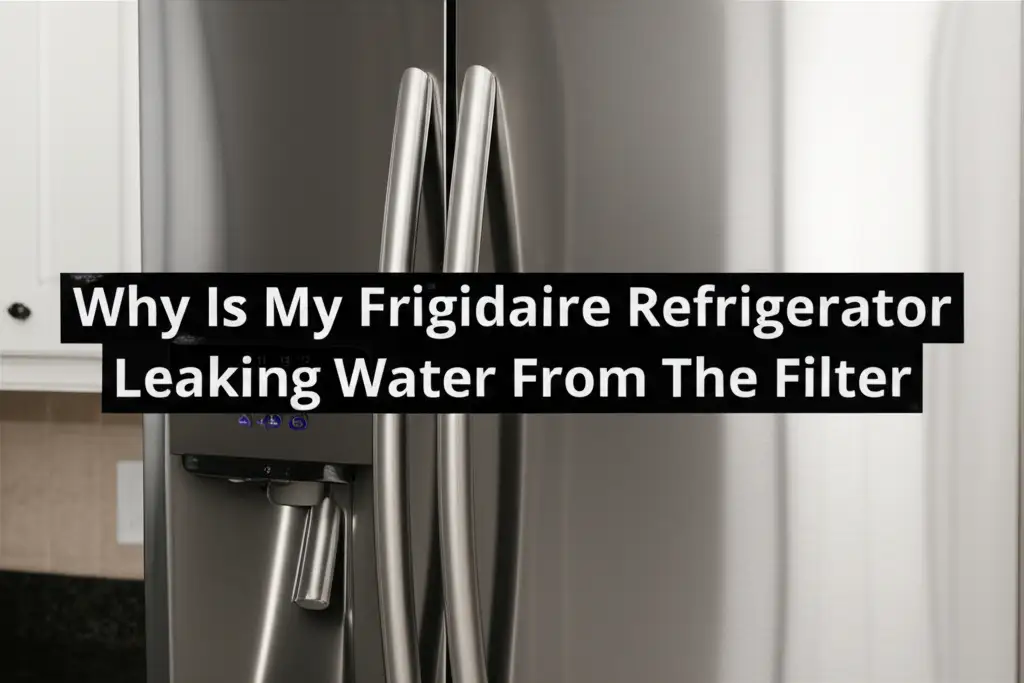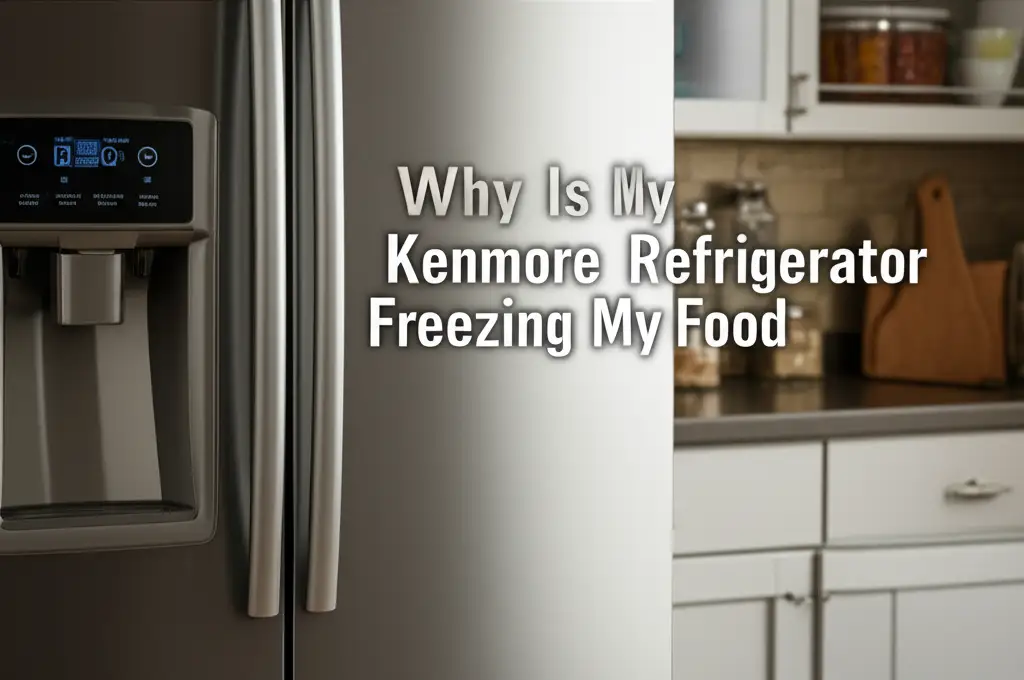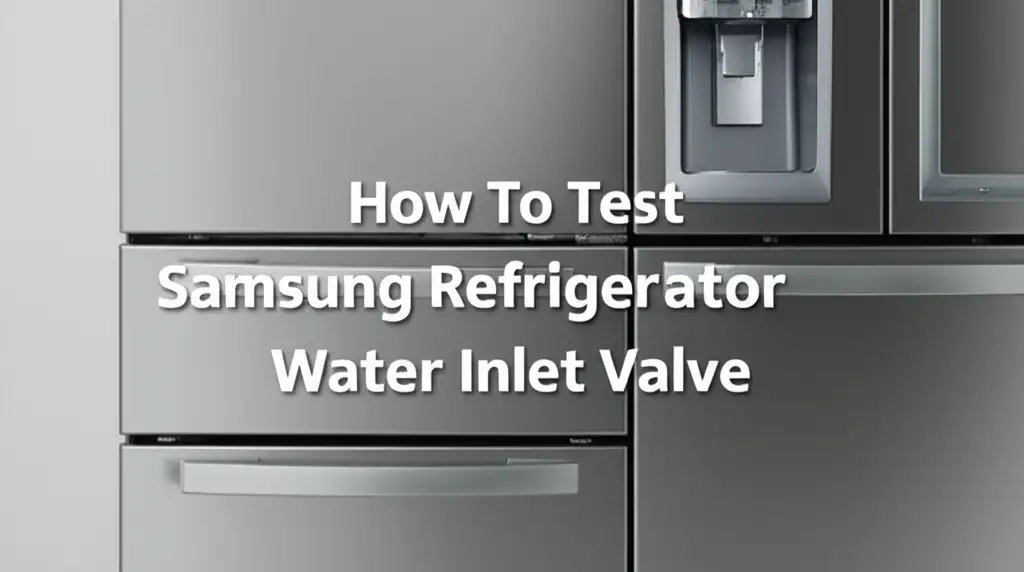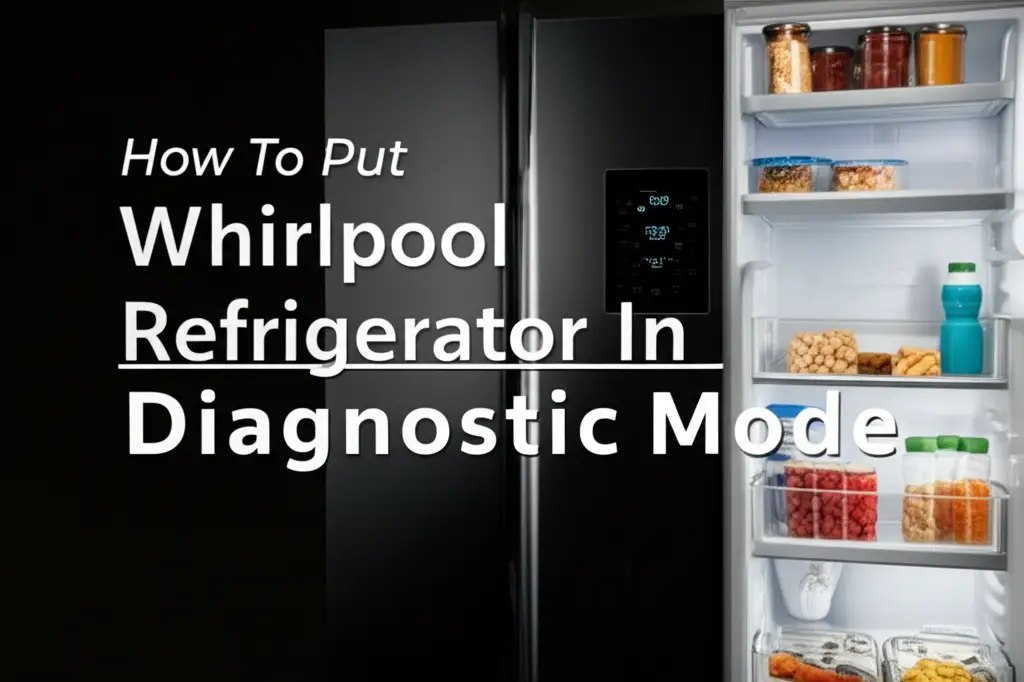· Katria Melrose · Appliance Repair · 20 min read
Why Is My Samsung Refrigerator Water Filter Leaking
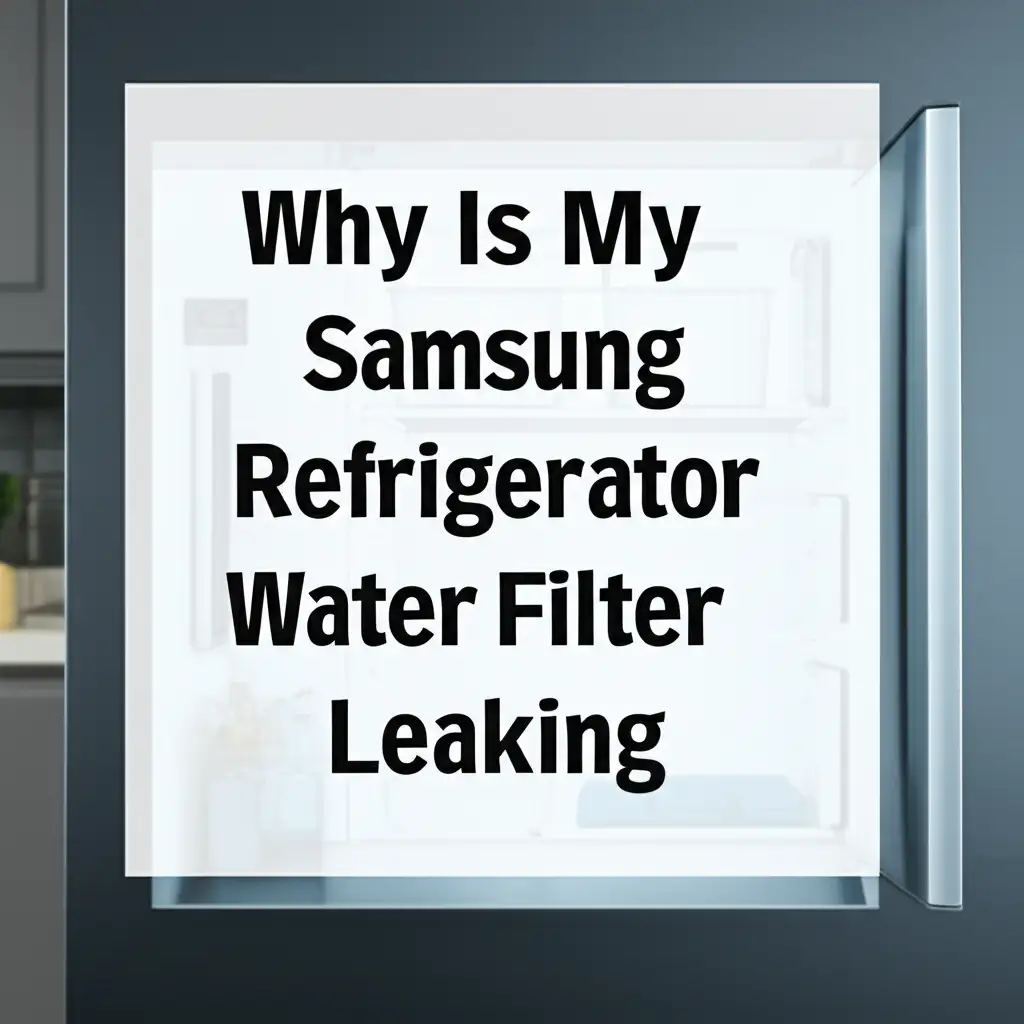
Understanding Your Samsung Refrigerator Water Filter Leak
It’s a common household frustration: you walk by your Samsung refrigerator and notice a puddle of water. Often, the culprit points directly to the water filter area. A leaking Samsung refrigerator water filter can be messy and concerning. It might signal a minor issue or something more serious.
This article helps you find the leak. We will explore the most common reasons why your Samsung refrigerator water filter leaks. We cover everything from simple installation errors to component failures. You will learn practical steps to diagnose the problem. We also provide clear solutions to stop the leak. My goal is to empower you with the knowledge to fix this issue yourself.
Takeaway:
- Check Installation: Ensure the water filter is correctly seated and twisted into place.
- Inspect O-Rings: Look for missing, damaged, or misaligned rubber O-rings on the filter or housing.
- Use Genuine Filters: Always use Samsung-approved filters to ensure proper fit and seal.
- Examine Housing & Lines: Check the filter housing and water lines for cracks or loose connections.
- Manage Water Pressure: Verify your home’s water pressure is within the refrigerator’s operating limits.
A Samsung refrigerator water filter leaks mainly due to incorrect installation, a faulty or non-genuine filter, or damaged components like O-rings or the filter housing. High water pressure can also stress the system, causing water to escape. Identifying the specific cause helps in a quick repair.
Common Culprits: Incorrect Filter Installation and Generic Filters
A common reason for a leaking Samsung refrigerator water filter often relates to how it was installed. Many people replace their water filters, but sometimes a small mistake can lead to a big mess. If the filter is not seated correctly, water can escape. This is a very common scenario.
When you insert a new filter, it must align perfectly with the filter housing. Then you twist it into place. You should feel a definite stop or click. If it feels loose or does not turn all the way, it is likely not installed properly. An improperly installed filter creates a gap. Water then finds this gap and drips out. Always ensure the filter locks securely.
Another significant issue comes from using generic or non-genuine water filters. Samsung designs its refrigerators to work with specific filter models. These filters have precise dimensions and seal points. Generic filters might look similar but can have slight variations. These small differences prevent a perfect seal.
I always recommend using genuine Samsung water filters. They guarantee the best fit. A non-genuine filter can lead to continuous leaks. It might also reduce filtration effectiveness. Some generic filters use different plastics or seal designs. These can fail under normal water pressure. Stick to the filters recommended by Samsung. It saves you trouble and potential water damage. Learn more about why your Samsung refrigerator might be leaking water from the filter.
Using the wrong filter or installing it incorrectly is a primary cause of leaks. This causes unnecessary stress for many owners. Taking a moment to check these two points can solve most filter-related leaks. Always follow the manufacturer’s instructions for filter replacement. This ensures a secure and leak-free connection.
Improper Seating and Alignment
When you replace your water filter, proper seating is crucial. Each Samsung filter has specific grooves and a locking mechanism. You must align these parts correctly before twisting. If you force the filter, you risk damaging the housing or the filter itself. This damage leads directly to leaks.
Push the filter in firmly but gently. Then, twist it until it locks. You should hear a click or feel it snap into position. If the filter is crooked or not fully engaged, water will bypass the seal. It will then leak from the connection point. I have seen many cases where a slight misalignment causes a persistent drip. Always double-check the filter’s position. Make sure it is completely seated before turning on the water supply.
Generic Filter Compatibility Issues
Generic water filters often promise savings. However, they can cost you more in the long run. Samsung designs its filter housing with precise specifications. Generic filters may not meet these exact tolerances. Their O-rings might be slightly thinner or thicker. The filter body might be a fraction of a millimeter off.
These tiny differences prevent a watertight seal. Water then leaks around the filter. This can happen immediately or develop over time. I strongly advise using only Samsung-approved filters. They are tested to fit perfectly. This ensures optimal performance and prevents leaks. Your refrigerator’s water system relies on these precise measurements for a leak-free operation.
The Role of O-Rings and Seals in Preventing Leaks
O-rings are small, rubber rings. They play a huge role in preventing leaks around your Samsung refrigerator water filter. Think of them as the primary seals. These rings create a watertight barrier between the filter and its housing. If these O-rings are damaged, missing, or out of place, water will escape. This is a very common cause of leaks.
When you remove an old filter, sometimes an O-ring can stick to the old filter or fall off. If the new filter goes in without its O-rings, or if the old ones are still in the housing, it causes a problem. Two O-rings typically seal the connection. One is usually on the filter itself, and another might be in the housing. They ensure a snug fit.
Look closely at the new water filter. It should have one or two rubber O-rings already on it. Check the filter housing inside your refrigerator as well. Sometimes, an old O-ring might remain stuck inside the housing when you remove the old filter. If you then insert a new filter with its O-rings, you end up with too many. This can prevent a proper seal and cause a leak.
Damaged O-rings also lead to leaks. Over time, rubber can degrade. It can become brittle or crack. Sometimes, overtightening the filter can pinch or deform an O-ring. If you see any signs of wear, a tear, or flattening, the O-ring needs replacement. A new water filter usually comes with new O-rings. Always make sure they are present and in good condition before installation. A small amount of food-grade silicone grease can help lubricate O-rings. This allows them to seat properly and extends their life. It also makes future filter changes easier.
A healthy O-ring forms a complete seal. A compromised one lets water through. Always take a moment to inspect these critical components when changing your filter. It is a simple step that prevents many common leaks. This small inspection saves you from bigger problems.
Missing or Displaced O-Rings
Sometimes, you might remove the old water filter, and an O-ring stays inside the refrigerator’s filter housing. When you install a new filter, it comes with its own O-rings. This results in two O-rings trying to occupy the same space. This creates an improper seal. Water will then leak around the filter.
Always check the filter housing after removing the old filter. Make sure no O-rings are left behind. Similarly, verify the new filter has its O-rings in place. They are crucial for a tight seal. Without them, or with too many, the connection becomes vulnerable to leaks. This is a simple visual check. It can prevent significant water damage.
Damaged or Degraded O-Rings
O-rings are made of rubber. Over time, rubber can dry out, crack, or become brittle. This is especially true in environments with temperature fluctuations. When an O-ring loses its elasticity, it cannot form a tight seal anymore. It may appear flattened or stretched.
Even a tiny crack or tear in an O-ring is enough for water to escape. Always inspect the O-rings on your new filter. Make sure they are smooth and intact. If they look worn or damaged, do not use that filter. A fresh, properly seated O-ring is essential for preventing leaks. I’ve seen how often this small component is overlooked.
Dealing with Cracked Filter Housings and Water Lines
While less common than O-ring issues or installation errors, a cracked filter housing or damaged water line can definitely cause your Samsung refrigerator water filter to leak. These are more serious problems. They often require professional attention or replacement parts. It is important to inspect these components if simpler solutions do not stop the leak.
The filter housing is the part inside your refrigerator where the water filter screws or slides in. This housing is usually made of plastic. Over time, or due to excessive force, it can develop hairline cracks. Overtightening the water filter can sometimes cause stress fractures. Freezing temperatures, if the refrigerator malfunctions or is in an unheated space, can also crack the plastic. Water expands when it freezes, putting immense pressure on the housing.
You might not see these cracks immediately. Water will slowly seep out. You may notice drips coming from around the base of the filter housing, not directly from the filter connection point. To check for cracks, you might need a flashlight and a keen eye. Look for any visible fissures on the plastic housing itself. If you find a crack, the housing usually needs replacement. This is not a simple DIY fix for most people.
Water lines are another potential source of leaks. These are the thin plastic or copper tubes that supply water to the filter and then to the dispenser or ice maker. They can connect to the back of the refrigerator and run internally to the filter housing. Over time, these lines can become brittle. They might develop small holes or cracks due to age, vibration, or even accidental punctures.
Connections where water lines meet the filter housing can also loosen. A fitting might become unthreaded slightly, allowing water to drip. Check these connection points. Make sure they are snug. If a water line itself is cracked, you will see water leaking along its path. In some cases, a small section of a plastic line can be cut out and repaired with a compression fitting. However, extensive damage or leaks within the refrigerator’s internal lines require a technician. Identifying these issues can be tricky. But a careful visual inspection is your first step. Sometimes, water can leak from underneath your Samsung refrigerator, which might relate to line issues.
Cracks in the Filter Housing
The filter housing holds the water filter in place. It directs water through the filter. This plastic component can crack from various stresses. Forcing a filter into place can cause micro-fractures. Extreme temperature changes, such as freezing within the lines, also make the plastic brittle.
A cracked housing allows water to bypass the sealed system. It then drips or sprays into the refrigerator compartment or onto the floor. Inspect the housing closely for any visible cracks or signs of stress. This usually requires removing the filter for a clear view. If you find a crack, replacing the entire housing is often the only permanent solution. This repair may require a professional.
Damaged or Loose Water Lines
Water supply lines carry water to and from the filter. These lines can be made of plastic or braided steel. Over time, plastic lines can become brittle and crack. They can also get pinched or kinked, leading to weak spots. Braided lines might fray or disconnect at their fittings.
Check the connections where the water lines attach to the filter housing. Ensure they are tight. If a line itself is damaged, you will see a steady drip or stream of water along its length. A small leak might appear as condensation or pooling water. Repairing a damaged water line can involve cutting out the bad section and using a repair coupling. However, for internal lines, professional help is best.
Water Pressure and Its Impact on Your Filter System
High water pressure can cause your Samsung refrigerator water filter to leak. Refrigerators, like most appliances, are designed to operate within a specific water pressure range. If the pressure in your home’s plumbing system exceeds this range, it puts undue stress on all components. This includes the water filter and its housing.
Imagine a balloon. If you fill it with too much air, it bursts. Similarly, excessive water pressure can overwhelm the seals and connections in your filter system. The O-rings, which are designed to hold back water up to a certain pressure, can fail. They might get pushed out of place. The constant strain can also weaken the plastic of the filter housing over time, leading to cracks.
Most refrigerators work best with water pressure between 20 and 120 pounds per square inch (psi). Your Samsung refrigerator’s manual will specify its recommended range. If your home’s water pressure is consistently above 80 psi, it could be the reason for persistent leaks. You can test your home’s water pressure using a simple water pressure gauge. You can buy one at any hardware store. Attach it to an outdoor spigot or your laundry room faucet.
If your water pressure is too high, you will need to install a pressure regulator on your main water supply line. A pressure regulator reduces and maintains water pressure at a safe level. This protects all your appliances, not just your refrigerator. It is a one-time installation that can save you from repeated appliance damage.
Sometimes, pressure spikes can also cause issues. These are temporary increases in pressure. They can happen when city water mains are flushed. They can also occur if other water-using appliances in your home suddenly stop. While harder to diagnose, consistent high pressure is a more common issue. Addressing water pressure issues is a proactive step. It prevents future leaks and extends the life of your refrigerator’s water system. Do not underestimate the power of water pressure. It is a silent force that can cause significant damage.
Excessive Household Water Pressure
Most Samsung refrigerators operate optimally with water pressure between 20 and 120 psi. Pressure above this range can strain the water filter system. High pressure can force water past seals. It can also cause O-rings to dislodge. The constant stress can even lead to premature wear or cracking of the filter housing.
You can check your home’s water pressure with a gauge. If it reads consistently high (above 80 psi is often a concern), consider installing a pressure regulator. This device reduces the incoming water pressure to a safe level. It protects your refrigerator and other appliances from damage caused by excessive pressure. This simple step can prevent many types of leaks.
Water Hammer or Pressure Spikes
Water hammer is a phenomenon where water flowing through a pipe suddenly stops or changes direction. This creates a shock wave that produces a banging noise and a sudden, significant spike in pressure. This sharp increase in pressure can momentarily exceed the system’s tolerance. It puts immense stress on the water filter and its connections.
Repeated water hammer can weaken seals and fittings over time. It can even cause hairline cracks in plastic components. While less common, these pressure spikes can be a culprit if leaks occur intermittently. Installing water hammer arrestors can mitigate this issue. They absorb the shock wave, protecting your plumbing and appliances from sudden pressure surges.
Routine Maintenance and Troubleshooting Steps
Regular maintenance helps prevent leaks and keeps your Samsung refrigerator’s water system running smoothly. It is not just about fixing a leak when it happens. It is about preventing it in the first place. Following a few simple steps can save you time, money, and hassle. Troubleshooting a leak also involves a systematic approach to pinpoint the exact problem.
First, always change your Samsung refrigerator water filter on schedule. Most manufacturers recommend replacement every six months. An old, clogged filter can restrict water flow. This can sometimes lead to pressure buildup in certain parts of the system. While not a direct cause of leaks at the filter connection, it contributes to overall system stress. It is a good idea to know how to reset your water filter on a Samsung Smart Refrigerator after changing it.
When replacing the filter, always follow the instructions precisely. I cannot stress this enough. Each Samsung model might have slight variations in how the filter installs. Ensure the water supply is turned off before you begin. This prevents a flood when you remove the old filter. When inserting the new filter, make sure it clicks securely into place. Feel it. Listen for the sound. Then, turn the water supply back on slowly. Listen and look for immediate drips.
After installing a new filter, run a few gallons of water through the dispenser. This purges air from the system. It also flushes out any carbon dust from the new filter. Air trapped in the lines can cause sputtering and temporary pressure fluctuations. While not a direct cause of leaks, it is a good practice. You can often change a Samsung refrigerator water filter without turning off the water, but knowing how helps.
If you notice a leak, start by turning off the water supply to the refrigerator immediately. This stops the flow and prevents further damage. Then, remove the water filter. Inspect the O-rings on the filter and inside the housing. Look for any signs of damage or displacement. Wipe down the area. Reinstall the filter carefully, ensuring a snug fit. Turn the water back on slowly and observe. Sometimes, simply re-seating the filter fixes the problem.
If the leak persists, consider replacing the filter with a new one. Even a brand-new filter can sometimes be faulty. Ensure it is a genuine Samsung part. If a new, properly installed filter still leaks, then you might be dealing with a cracked housing or a faulty water line. These require more in-depth diagnosis. If you’re wondering, yes, you can often run your Samsung refrigerator without the water filter installed temporarily to check for leaks originating elsewhere.
Regular Filter Replacement Schedule
Manufacturers design water filters to last for a specific period, typically six months. Exceeding this lifespan can lead to a clogged filter. A clogged filter restricts water flow, forcing the refrigerator’s water pump to work harder. While this may not directly cause leaks at the filter itself, it puts stress on the entire water system. This stress can exacerbate existing weaknesses in seals or connections.
Adhering to the replacement schedule ensures optimal water filtration and maintains appropriate water flow and pressure through the system. This proactive approach minimizes strain on components. It helps prevent future leaks. Always use the recommended filter type for your Samsung model.
Step-by-Step Troubleshooting for Leaks
When you discover a leak, act quickly. First, turn off the water supply to your refrigerator. This stops the leak. Next, remove the water filter. Carefully inspect the O-rings on the filter and inside the filter housing. Look for any damage, twists, or missing rings. Clean the area.
Reinsert the filter, ensuring it clicks firmly into place. Slowly turn the water supply back on. Watch for any immediate drips. If the leak stops, great! If it continues, try a brand-new, genuine Samsung filter. If the new filter still leaks after proper installation, the problem likely lies with the filter housing or water lines. At this point, further inspection or professional help is warranted.
Identifying Your Samsung Refrigerator’s Water Filter Location
Knowing where your Samsung refrigerator’s water filter is located is the first step in addressing any leaks. Samsung refrigerators use various filter designs and placements. The filter location can vary significantly between models. This directly impacts how you access and replace it.
Many Samsung models feature an internal water filter. This filter is typically found inside the refrigerator compartment. Common locations include:
- Top Right Corner: Many popular Samsung French door and side-by-side models have the filter located in the upper right-hand corner of the fresh food compartment. It often has a twist-out or push-button release mechanism. You usually twist it counter-clockwise to remove and clockwise to install.
- Inside a Bottom Grille Compartment: Some older or specific side-by-side models might have the filter behind the bottom grille. This means you have to pull the grille off to access it. These filters usually have a push-in, push-out release.
- Middle of the Refrigerator: Less common, but some models might have a filter compartment located in the middle section, often near the vegetable crispers.
External water filters are another possibility, though less common on newer Samsung models. An external filter is located outside the refrigerator. It is usually in the water line behind the appliance. You would see it between the water shut-off valve and the refrigerator’s water inlet. These filters are typically inline and have quick-connect fittings.
Before you start troubleshooting a leak, consult your Samsung refrigerator’s user manual. The manual provides the exact location of the water filter for your specific model. It also details the correct removal and installation procedures. Following these instructions is crucial. An improper removal or installation can cause the very leaks you are trying to fix. Identifying the correct location ensures you are working on the right component. This saves you time and prevents frustration. Once you know the location, you can proceed with inspection and repair steps with confidence.
Internal Filter Locations
Most Samsung refrigerators place the water filter inside the fresh food compartment. This makes it convenient to access. Common spots include the upper right corner. Here, the filter often twists out like a bottle. You usually push a button, then twist. Other models might place it inside the bottom grille. You might need to remove the grille to see it. It then typically pushes in or out. Always check your specific model’s manual for the exact spot and method. Knowing the location prevents unnecessary searching.
External Filter Locations (Less Common)
Some Samsung refrigerators, particularly older ones or those connected to whole-house filtration systems, might use an external inline filter. This filter is located outside the refrigerator. You will find it in the water supply line behind the appliance. It connects directly to the plastic or copper water line that feeds the refrigerator. These filters often have quick-connect fittings on either end. If you have an external filter, check its connections for leaks. Also, inspect the filter housing itself for cracks. These external filters are typically straightforward to replace.
When to Call a Professional: Knowing Your Limits
While many Samsung refrigerator water filter leaks are fixable with DIY methods, some situations warrant calling a professional appliance technician. Knowing when to seek expert help can save you from further damage. It also prevents more expensive repairs in the long run. Do not hesitate to call for help if you feel uncertain.
If you have tried all the common troubleshooting steps and the leak persists, it is time to consider professional assistance. This includes:
- Replacing the filter correctly: You have ensured the filter is genuine, properly installed, and the O-rings are intact.
- Checking water pressure: You have verified your home’s water pressure is within the recommended range.
- Inspecting for visible damage: You have looked for cracks in the housing or lines, but cannot find an obvious issue, or the damage seems severe.
One clear sign to call a professional is if you suspect a crack in the filter housing itself. Replacing a filter housing typically involves disassembling parts of the refrigerator’s internal water system. This can be complex. It might require specialized tools. Mishandling these internal components can lead to bigger problems. It could even void your refrigerator’s warranty.


